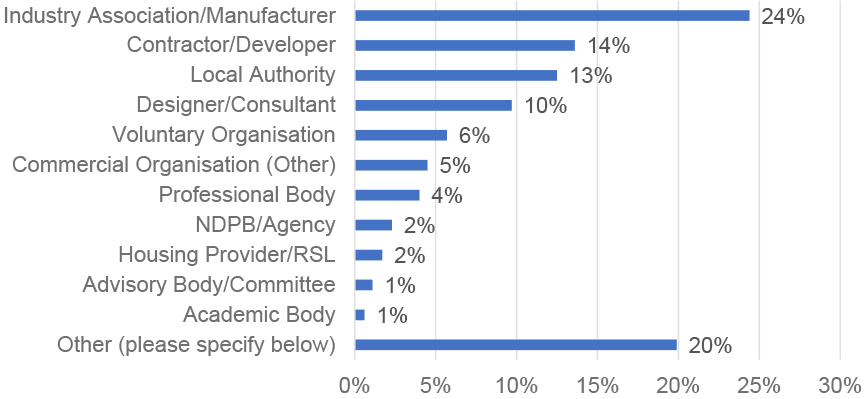Building regulations - proposed changes to energy standards, etc: consultation analysis
An analysis of the responses to the 2021 public consultation on a review of building standards relating to energy standards and associated topics, including ventilation, overheating and electric vehicle charging infrastructure.
2 Methodology and respondent profile
2.1.1 Methodology
In total, 176 responses to the consultation were received.
All responses were checked for duplicates: one duplicate was identified and removed before analysis was undertaken.
Qualitative analysis of open questions was undertaken manually, with responses coded to identify the main themes for reporting. All responses to the open questions were weighted equally in the analysis. This report presents the main themes evident in the responses to each question, together with the number of respondents raising each respective theme. The following convention has been used to indicate the frequency of particular themes:
- Few: up to three responses
- Several: four to nine responses
- Many: 10 or more responses
Closed questions were analysed using SNAP software and reported by respondent type (organisation type and ‘individual’). A profile of respondents is provided in section 2.3.
2.1.2 Campaign responses
Identical responses were checked, and ‘standard’ and ‘non-standard’ responses were identified.
- Standard campaign responses were counted, and the numbers reported and all but one response excluded from the master database for analysis. This report includes one standard campaign response. A standard campaign response is where all responses are identical.
- Non-standard campaign responses were counted, and numbers reported but all non-standard campaign responses are included in the master database for analysis. This report includes one non-standard campaign response. Non-standard campaign responses are similar, but not identical.
2.1.3 Respondents
One hundred and forty-two of the responses were received via the government consultation platform ‘Citizen Space’. Thirty-four additional responses were received via ministerial correspondence and emails. These were inputted manually into Citizen Space. The Scottish Government received, acknowledged, and logged all written responses.
‘Individuals’ account for 11% of the total respondents, and 89% were organisations (Figure 1).

Base: 176 respondents
The types of organisations that responded to the survey are illustrated in Figure 2. Industry Association/Manufacturer was the most common type of organisation to respond, followed by Contractor/Developer.

Base: 176 respondents
Note: individuals are double counted in the respondent profile above as, within the questionnaire, individuals responding were asked to select an organisation type. All 20 individuals who responded to the consultation answered the question: ‘If responding on behalf of an organisation please select the most relevant type of organisation from the list below’.
Of these 20 individuals, 13 selected ‘other’, four selected ‘designer/consultant’, and one each selected ‘local authority’, ‘voluntary organisation’ and ‘academic body’.
Of the 22 organisations who selected ‘other’ the responses included:
- Charities
- A ‘collaboration between Local Authority, Academic Body, Housing Provider/RSL & Contractor/Developer’
- Landowner
- Competent person scheme
- Advocacy organisation
- Fire and Rescue Service
- Independent Chairman and Technical Committee Chairman
- Industry Trade Federation
- Membership Body
- Non-governmental organisation (NGO)
- Professional Body, Industry association/manufacturer and Advisory body/committee
- Regulated electricity network
- Trade Body or Association
This report presents a full numerical description of the types of responses received, confirming total number of responses received and numbers by different categories of response. This includes the total number of responses by individuals, by organisations and combined total number of campaign responses (including how many responses were received per campaign).
Responses from ‘individuals’ are also counted amongst some organisation types. Base numbers beneath charts include all respondents, regardless of whether they are from an individual, or from an organisation.
2.1.4 Satisfaction with the consultation
Overall, respondents were satisfied with the consultation, with 58% stating they were either ‘very satisfied’ or ‘slightly satisfied’. Just under a third (32%) were neutral.
Most respondents were also satisfied with using Citizen Space to respond to the consultation: 68% stating they were ‘very satisfied’ or ‘satisfied’. Note: there was an error in the response options for this question. There were two ‘slightly satisfied’ options and no ‘slightly dissatisfied’ option.
Seventy-six per cent of respondents gave permission for their response to be published. The majority of respondents (95%) were happy for their response to be shared internally with other Scottish Government departments.
2.1.5 Report structure
The rest of this report is organised to reflect the structure of the consultation document:
- Section 3 reports on Part 2: Energy, new buildings
- Section 4 reports on Part 3: Energy, all buildings
- Section 5 reports on Part 4: Ventilation
- Section 6 reports on Part 5: Overheating risk in new dwellings and other new residential buildings
- Section 7 reports on Part 6: Improving and demonstrating compliance
- Section 8 reports on Part 7: Electric vehicle charging infrastructure
Contact
Email: buildingstandards@gov.scot
There is a problem
Thanks for your feedback